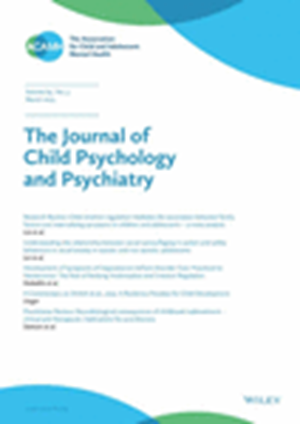自闭症儿童和青少年并存的精神健康和神经发育状况的初步诊断模式:来自加拿大全国代表性样本的证据
IF 7
1区 医学
Q1 PSYCHIATRY
引用次数: 0
摘要
背景在自闭症患者中已经观察到共存健康状况的患病率升高,然而他们最初诊断的时间如何随自闭症诊断的性别和年龄而变化仍未得到充分研究。采用以人为中心的方法,我们检查了从一般人群中确定的自闭症儿童和青少年的心理健康和神经发育状况的初始诊断模式。方法样本来自2019年加拿大儿童和青少年健康调查(CHSCY)队列(N = 47,781),包括776名5-17岁的儿童(82%为出生时男性),他们的照护者报告诊断为自闭症。采用多组潜在分类分析,根据自闭症、焦虑、情绪、学习和注意缺陷/多动障碍的初始诊断年龄,按出生性别分层,确定亚组。功能困难和多病状态,包括共存条件的数量和类型,在亚组之间进行比较。结果每个性别组均有4个潜在亚组,主要以自闭症诊断年龄进行区分。最普遍的一类(46%)在3-5岁时被诊断为自闭症。其余的亚组,主要是在3岁之前,6-8岁和9-17岁时诊断出自闭症,每个亚组占样本的20%左右。6岁以后被诊断为自闭症的亚组倾向于有更多的共存条件,女性在从出生到17岁的整个年龄窗口中显示出更高的心理健康诊断概率。共存诊断相对于自闭症诊断的时间顺序在不同的亚组中有所不同,性别差异在焦虑和注意缺陷/多动障碍中更为明显。结论:基于自闭症诊断的年龄,共存条件的初始诊断时间存在细微差异。性别差异模式强调了对自闭症儿童和青少年的神经发育和心理健康需求进行持续监测和评估的重要性,并根据性别和自闭症诊断时间提供量身定制的支持。本文章由计算机程序翻译,如有差异,请以英文原文为准。
Initial diagnosis patterns of coexisting mental health and neurodevelopmental conditions in autistic children and youth: Evidence from a nationally representative sample in Canada
BackgroundElevated prevalence of coexisting health conditions has been observed in autistic people, yet how the timing of their initial diagnoses varies by sex and age of autism diagnosis remains understudied. Using a person‐centered approach, we examined the patterns of initial diagnosis for mental health and neurodevelopmental conditions among autistic children and youth identified from the general population.MethodsThe sample was drawn from the 2019 Canadian Health Survey on Children and Youth (CHSCY) cohort (N = 47,781), consisting of 776 5–17‐year‐olds (82% assigned‐male‐at‐birth) with a caregiver‐reported diagnosis of autism. Multigroup latent class analysis was used to identify subgroups based on ages of initial diagnoses of autism, anxiety, mood, learning, and attention‐deficit/hyperactivity disorders stratified by sex assigned at birth. Functional difficulties and multimorbidity status, including the number and types of coexisting conditions, were compared across the subgroups.ResultsFour latent subgroups were identified for each sex group, primarily differentiated by the age of autism diagnosis. The most prevalent class (46%) was characterized by an initial autism diagnosis at ages 3–5 years. The remaining subgroups, with autism diagnosed primarily before age 3, at 6–8, and at 9–17 years, each comprised ~20% of the sample. Subgroups with autism diagnosed after age 6 tended to have more coexisting conditions, with females showing heightened probabilities of mental health diagnoses across age windows from birth to age 17 years. The temporal order of coexisting diagnoses relative to autism diagnosis varied across subgroups, with sex differences more evident for anxiety and attention‐deficit/hyperactivity disorders.ConclusionsThere were nuanced variations in the timing of initial diagnoses of coexisting conditions based on the age of autism diagnosis. The sex‐varying patterns highlight the importance of continuous monitoring and evaluation of the neurodevelopmental and mental health needs of autistic children and youth, with supports tailored to sex and the timing of autism diagnosis.
求助全文
通过发布文献求助,成功后即可免费获取论文全文。
去求助
来源期刊
CiteScore
13.80
自引率
5.30%
发文量
169
审稿时长
1 months
期刊介绍:
The Journal of Child Psychology and Psychiatry (JCPP) is a highly regarded international publication that focuses on the fields of child and adolescent psychology and psychiatry. It is recognized for publishing top-tier, clinically relevant research across various disciplines related to these areas. JCPP has a broad global readership and covers a diverse range of topics, including:
Epidemiology: Studies on the prevalence and distribution of mental health issues in children and adolescents.
Diagnosis: Research on the identification and classification of childhood disorders.
Treatments: Psychotherapeutic and psychopharmacological interventions for child and adolescent mental health.
Behavior and Cognition: Studies on the behavioral and cognitive aspects of childhood disorders.
Neuroscience and Neurobiology: Research on the neural and biological underpinnings of child mental health.
Genetics: Genetic factors contributing to the development of childhood disorders.
JCPP serves as a platform for integrating empirical research, clinical studies, and high-quality reviews from diverse perspectives, theoretical viewpoints, and disciplines. This interdisciplinary approach is a key feature of the journal, as it fosters a comprehensive understanding of child and adolescent mental health.
The Journal of Child Psychology and Psychiatry is published 12 times a year and is affiliated with the Association for Child and Adolescent Mental Health (ACAMH), which supports the journal's mission to advance knowledge and practice in the field of child and adolescent mental health.

 求助内容:
求助内容: 应助结果提醒方式:
应助结果提醒方式:


